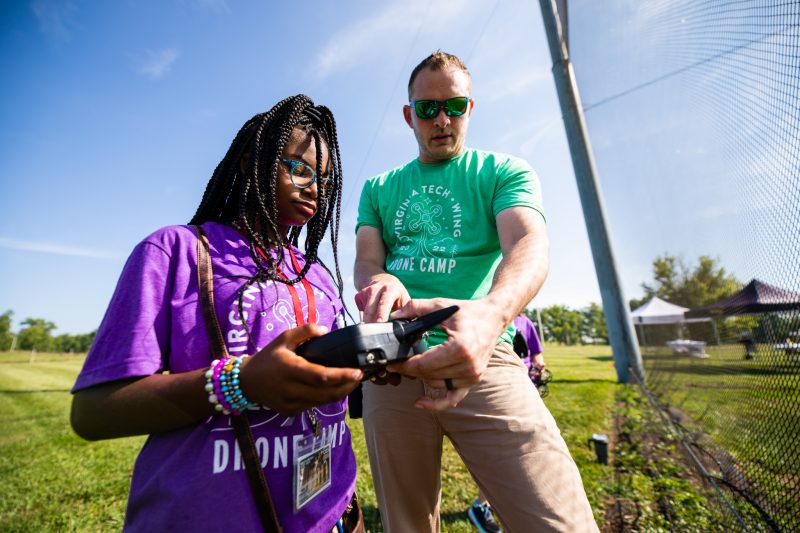
The 40 campers came from as far away as Wisconsin. Split into two teams, they waited with their flight controllers in hand at either end of Virginia Tech’s 300-foot-long drone park.
One by one, each camper walked to the edge of the net, aimed the controller at the drone on the other side of the net, and pushed the throttle forward. The drone hummed and floated off a wooden starting block, its four tiny propellers spinning furiously. The students pushed the joysticks up, down, right, left, trying to maneuver the drone toward an orange landing pad. The closer they got, the more points they earned.
The little quadcopters, just 150 grams each, swooped upward and swerved from side to side before touching down on the grass. A few crashed into the netting. One camper zoomed straight to the target, landed, then took off again and dropped the drone gracefully back onto the starting block.
The contest was the culmination of Virginia Tech’s very first drone camp. Every drone had been built by the campers themselves over the preceding week. Now, with their families — and a few family dogs — looking on, the rising seventh through ninth graders got to show off their handiwork.
The camp was part of the Imagination series developed by the Center for the Enhancement of Engineering Diversity in the College of Engineering to give underserved students an entry point into STEM fields.
Kim Lester, the center’s director of pre-college programs, said drones are a natural fit for Imagination.
“Sometimes technology is so abstract that it’s hard for kids to really connect with it,” she said. “Drones are engaging. They’re in the news. Middle school students know what they are, and the technology can be very accessible and hands on.”
The center developed the drone camp curriculum in collaboration with the Virginia Tech Mid-Atlantic Aviation Partnership (MAAP), the university’s Federal Aviation Administration-designated drone test site, and Wing, the Google sister company that launched the country’s first residential drone delivery service in Christiansburg in 2019.
Lester works with nonprofits, communities, and other partners to reach kids beyond the typical cohort that flocks to STEM camps. More than 60 percent of the students at the drone camp identified as Black or Hispanic. For more than 40 percent of them, neither parent had a four-year college degree.
“The families of the kids that we try to recruit for the Imagination camps are often not aware of what’s possible,” she said. “The technology to fill out an online application can be daunting. Transportation is a barrier. There are so many barriers that can keep families from pursuing an experience like this.”
Lester’s group tries to remove as many of those roadblocks as possible. All expenses for the six-day residential camp were covered, thanks to funding from Wing, MAAP, the Institute for Critical Technology and Applied Science, and the Kevin T. Crofton Department of Aerospace and Ocean Engineering.
Building the drones was the main attraction. Over the course of a few days, piles of circuit boards, tiny bolts, lightweight black frames, and clear plastic propellers became a fleet of 40 nimble racing drones. Each drone’s quartet of motors had to be placed in the correct positions; each flight controller had to be oriented the same way as the drone it was paired with. Engineers and pilots from MAAP and Virginia K-12 teachers looked on, guiding the campers through the process and helping them troubleshoot snags.
Toby Tracy, the MAAP engineer who led the build, said he could see the sense of accomplishment on the campers’ faces when they brought up their finished drones to plug them in for the first time.
“This was the make-or-break moment,” he said. “You check for the colored lights that tell you the receiver is talking to the transmitter. You flip the drone on and make sure all the motors are spinning. I taught them why I was using a multimeter. It was really an ‘aha’ moment. Being able to teach them something I love was just great.”



